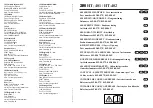
Symptoms
Cause
Action
The robotic lawnmow-
er runs, but the blade
disc does not rotate.
The robotic lawnmower searches for the
charging station.
No action. The blade disc does not rotate
when the robotic lawnmower is searching for
the charging station.
The robotic lawnmow-
er mows for shorter
periods than usual
between charges.
Grass or other foreign object blocks the blade
disc.
Remove and clean the blade disc. See
the robotic lawnmower on page 40.
The battery is spent.
Battery on page 41.
Both the mowing and
charging times are
shorter than usual.
The battery is spent.
Battery on page 41.
The robotic lawnmow-
er is parked for hours
in the charging sta-
tion.
The robotic lawnmower has an inbuilt standby
period according to the Standby time table.
See
Standby on page 38.
No action.
The hatch has been closed without the
START button first being pressed.
Open the hatch, press the START button and
then close the hatch.
Uneven mowing re-
sults.
The robotic lawnmower works too few hours
per day.
page 22.
Not applicable for R100Li, R100LiC. Sensor-
Control senses that the lawn hae been mow-
ed more than it actually has. Increase the in-
tensity level in the SensorControl. If this does
not help, turn off th SensorControl.
The
How often? setting is incorrect in relation
to the layout of the working area.
Check that the correct
How often? value is
selected.
The shape of the working area requires the
use of
Area 1-3 for the robotic lawnmower to
find its way to all remote areas.
Use
Area 1-3 to steer the robotic lawnmower
page 26.
Working area too large.
Try limiting the working area or extending the
Dull blades.
Replace all the blades. See
blades on page 41.
Long grass in relation to the set cutting
height.
Increase the cutting height and then succes-
sively lower.
Accumulation of grass by the blade disc or
around the motor shaft.
Check that the blade disc rotates freely and
easily. If not, screw off the blade disc and re-
move grass and foreign objects. See
the robotic lawnmower on page 40.
6.6 Find breaks in the loop wire
Breaks in the loop wire are usually the result of
unintentional physical damage to the wire such as when
gardening with a shovel. In countries with ground frost,
also sharp stones that move in the ground can damage
the wire. Breaks can also be due to the wire being
stretched excessively during installation.
Mowing the grass too low right after the installation can
damage wire insulation. Damage to the insulation may
not cause disruptions until several weeks or months
later. To avoid this, always select the maximum cutting
height the first weeks after installation and then lower
the height one step at a time every second week until
the desired cutting height has been reached.
A defective splicing of the loop wire can also lead to
disruptions several weeks after the splice was done. A
faulty splice can, for example, be the result of the
original coupler not being pressed together hard enough
with a pair of pliers, or that a coupler of lower quality
than the original coupler has been used. Please first
check all known splices before further troubleshooting is
done.
A wire break can be located by gradually halving the
distance of the loop where the break may have occurred
until there is only a very short section of the wire left.
The following method does not work if
ECO mode is
activated. Make sure first that
ECO mode is turned off.
See
ECO mode on page 29.
1. Check that the indicator lamp in the charging station
flashes blue, which indicates a break in the
48 - Troubleshooting
307 - 002 - 11.10.2017









































